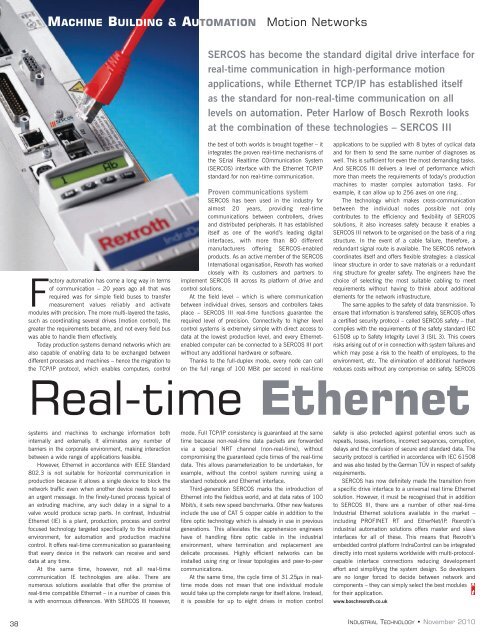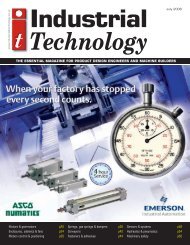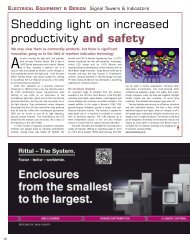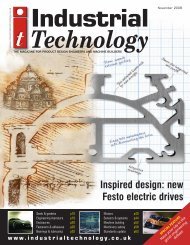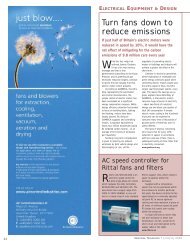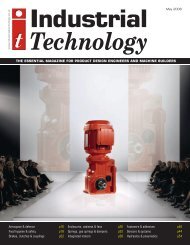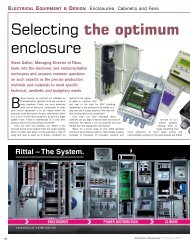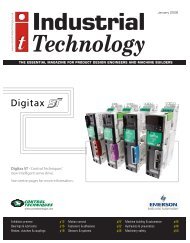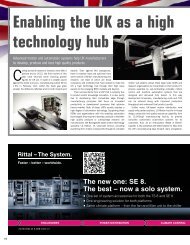machine building & automation - Industrial Technology Magazine
machine building & automation - Industrial Technology Magazine
machine building & automation - Industrial Technology Magazine
- No tags were found...
You also want an ePaper? Increase the reach of your titles
YUMPU automatically turns print PDFs into web optimized ePapers that Google loves.
MACHINE BUILDING & AUTOMATIONMotion NetworksSERCOS has become the standard digital drive interface forreal-time communication in high-performance motionapplications, while Ethernet TCP/IP has established itselfas the standard for non-real-time communication on alllevels on <strong>automation</strong>. Peter Harlow of Bosch Rexroth looksat the combination of these technologies – SERCOS IIIFactory <strong>automation</strong> has come a long way in termsof communication – 20 years ago all that wasrequired was for simple field buses to transfermeasurement values reliably and activatemodules with precision. The more multi-layered the tasks,such as coordinating several drives (motion control), thegreater the requirements became, and not every field buswas able to handle them effectively.Today production systems demand networks which arealso capable of enabling data to be exchanged betweendifferent processes and <strong>machine</strong>s – hence the migration tothe TCP/IP protocol, which enables computers, controlthe best of both worlds is brought together – itintegrates the proven real-time mechanisms ofthe SErial Realtime COmmunication System(SERCOS) interface with the Ethernet TCP/IPstandard for non real-time communication.Proven communications systemSERCOS has been used in the industry foralmost 20 years, providing real-timecommunications between controllers, drivesand distributed peripherals. It has establisheditself as one of the world’s leading digitalinterfaces, with more than 80 differentmanufacturers offering SERCOS-enabledproducts. As an active member of the SERCOSInternational organisation, Rexroth has workedclosely with its customers and partners toimplement SERCOS III across its platform of drive andcontrol solutions.At the field level – which is where communicationbetween individual drives, sensors and controllers takesplace – SERCOS III real-time functions guarantee therequired level of precision. Connectivity to higher levelcontrol systems is extremely simple with direct access todata at the lowest production level, and every Ethernetenabledcomputer can be connected to a SERCOS III portwithout any additional hardware or software.Thanks to the full-duplex mode, every node can callon the full range of 100 MBit per second in real-timeapplications to be supplied with 8 bytes of cyclical dataand for them to send the same number of diagnoses aswell. This is sufficient for even the most demanding tasks.And SERCOS III delivers a level of performance whichmore than meets the requirements of today’s production<strong>machine</strong>s to master complex <strong>automation</strong> tasks. Forexample, it can allow up to 256 axes on one ring. .The technology which makes cross-communicationbetween the individual nodes possible not onlycontributes to the efficiency and flexibility of SERCOSsolutions, it also increases safety because it enables aSERCOS III network to be organised on the basis of a ringstructure. In the event of a cable failure, therefore, aredundant signal route is available. The SERCOS networkcoordinates itself and offers flexible strategies: a classicallinear structure in order to save materials or a redundantring structure for greater safety. The engineers have thechoice of selecting the most suitable cabling to meetrequirements without having to think about additionalelements for the network infrastructure.The same applies to the safety of data transmission. Toensure that information is transferred safely, SERCOS offersa certified security protocol – called SERCOS safety – thatcomplies with the requirements of the safety standard IEC61508 up to Safety Integrity Level 3 (SIL 3). This coversrisks arising out of or in connection with system failures andwhich may pose a risk to the health of employees, to theenvironment, etc. The elimination of additional hardwarereduces costs without any compromise on safety. SERCOSReal-time Ethernetsystems and <strong>machine</strong>s to exchange information bothinternally and externally. It eliminates any number ofbarriers in the corporate environment, making interactionbetween a wide range of applications feasible.However, Ethernet in accordance with IEEE Standard802.3 is not suitable for horizontal communication inproduction because it allows a single device to block thenetwork traffic even when another device needs to sendan urgent message. In the finely-tuned process typical ofan extruding <strong>machine</strong>, any such delay in a signal to avalve would produce scrap parts. In contrast, <strong>Industrial</strong>Ethernet (IE) is a plant, production, process and controlfocused technology targeted specifically to the industrialenvironment, for <strong>automation</strong> and production <strong>machine</strong>control. It offers real-time communication so guaranteeingthat every device in the network can receive and senddata at any time.At the same time, however, not all real-timecommunication IE technologies are alike. There arenumerous solutions available that offer the promise ofreal-time compatible Ethernet – in a number of cases thisis with enormous differences. With SERCOS III however,mode. Full TCP/IP consistency is guaranteed at the sametime because non-real-time data packets are forwardedvia a special NRT channel (non-real-time), withoutcompromising the guaranteed cycle times of the real-timedata. This allows parameterization to be undertaken, forexample, without the control system running using astandard notebook and Ethernet interface.Third-generation SERCOS marks the introduction ofEthernet into the fieldbus world, and at data rates of 100Mbit/s, it sets new speed benchmarks. Other new featuresinclude the use of CAT 5 copper cable in addition to thefibre optic technology which is already in use in previousgenerations. This alleviates the apprehension engineershave of handling fibre optic cable in the industrialenvironment, where termination and replacement aredelicate processes. Highly efficient networks can beinstalled using ring or linear topologies and peer-to-peercommunications.At the same time, the cycle time of 31.25µs in realtimemode does not mean that one individual modulewould take up the complete range for itself alone. Instead,it is possible for up to eight drives in motion controlsafety is also protected against potential errors such asrepeats, losses, insertions, incorrect sequences, corruption,delays and the confusion of secure and standard data. Thesecurity protocol is certified in accordance with IEC 61508and was also tested by the German TÜV in respect of safetyrequirements.SERCOS has now definitely made the transition froma specific drive interface to a universal real time Ethernetsolution. However, it must be recognised that in additionto SERCOS III, there are a number of other real-time<strong>Industrial</strong> Ethernet solutions available in the market –including PROFINET RT and EtherNet/IP. Rexroth’sindustrial <strong>automation</strong> solutions offers master and slaveinterfaces for all of these. This means that Rexroth’sembedded control platform IndraControl can be integrateddirectly into most systems worldwide with multi-protocolcapableinterface connections reducing developmenteffort and simplifying the system design. So developersare no longer forced to decide between network andcomponents – they can simply select the best modulesfor their application.www.boschrexroth.co.uk38INDUSTRIAL TECHNOLOGY • November 2010


